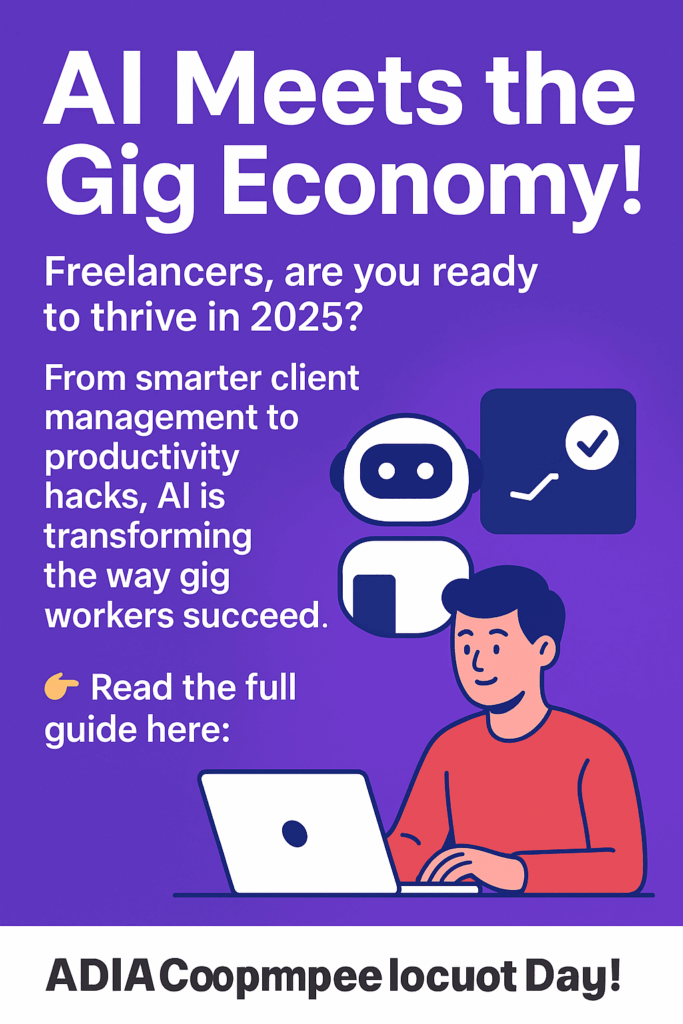AI and the Gig Economy: How Freelancers Can Leverage Artificial Intelligence for Growth

Introduction
The gig economy is expanding at lightning speed. From freelance writers and designers to ride-hailing drivers and virtual assistants, millions of professionals are choosing independence over traditional employment. Yet, the growing competition has made it harder to stand out. This is where Artificial Intelligence (AI) becomes a game-changer.
AI is no longer a futuristic idea—it is an everyday tool that gig workers can use to boost productivity, win more clients, and increase income. For freelancers, embracing AI is not about replacing human creativity or effort but about using intelligent systems to work smarter, faster, and more effectively.
This article explores how gig workers can harness AI to grow, sustain, and scale their freelance careers.
The Rise of the Gig Economy
The gig economy refers to flexible, short-term, and project-based work arrangements. Platforms like Upwork, Fiverr, TaskRabbit, and Uber have given workers opportunities to monetize skills without the restrictions of traditional employment.
According to recent reports, the gig economy is projected to generate $455 billion by 2025, with freelancers making up over 50% of the U.S. workforce by 2030. Similar growth trends are happening worldwide, especially as remote work becomes mainstream.
However, with millions of freelancers entering the market, competition is fierce. Standing out requires efficiency, specialization, and strong personal branding—areas where AI tools can provide a massive edge.
How Freelancers Can Leverage AI
- AI for Productivity and Task Management
Freelancers often juggle multiple clients, deadlines, and administrative tasks. AI-powered productivity apps simplify this chaos:
Notion AI and ClickUp AI help organize workflows, automate reminders, and even summarize project briefs.
GrammarlyGO and Jasper assist in drafting emails, proposals, and reports with speed and accuracy.
AI scheduling tools like Motion or Reclaim optimize time management, ensuring deadlines are met.
- AI for Marketing and Client Acquisition
Winning clients is the lifeblood of freelancing. AI-driven platforms can:
Analyze job listings to match freelancers with high-paying opportunities.
Personalize pitches by scanning client websites and tailoring proposals.
Run ad campaigns with AI-powered marketing platforms like AdCreative.ai, which generate high-converting ad visuals and copy.
By automating repetitive tasks, freelancers can focus more on delivering value to clients.
- AI for Creative Work
Creative freelancers—writers, designers, video editors, and musicians—are using AI to amplify their talents:
Writers can use ChatGPT or Sudowrite to brainstorm content ideas.
Designers leverage Canva AI or MidJourney to create high-quality visuals quickly.
Video editors use Runway ML for background removal, subtitle generation, and fast editing.
Musicians and podcasters can use AIVA or Soundraw to generate custom soundtracks.
AI does not replace creativity but accelerates the process. It allows freelancers to scale their output and offer more services.
- AI for Financial Management
Managing finances is one of the biggest challenges for gig workers. AI tools now make this easier:
QuickBooks AI helps track expenses, generate invoices, and predict cash flow.
AI tax assistants suggest deductions freelancers may overlook.
Budgeting apps like Cleo use AI chatbots to coach freelancers on saving and investing.
By automating accounting, freelancers can focus on growth rather than paperwork.
- AI for Skill Development
Continuous learning is essential in the gig economy. AI learning platforms personalize courses and recommend upskilling paths:
Coursera AI suggests courses based on career goals.
Duolingo AI accelerates language learning for freelancers targeting global clients.
LinkedIn Learning integrates AI recommendations for industry trends.
Upskilling ensures freelancers stay competitive in an evolving digital economy.
Case Studies: Freelancers Winning with AI
- The Freelance Writer – Using Jasper AI, a content creator doubled output, allowing her to serve five clients instead of two. Her income grew by 150% within six months.
- The Graphic Designer – A designer leveraged MidJourney to produce unique logo concepts in minutes. This reduced turnaround time and attracted more premium clients.
- The Virtual Assistant – A VA integrated Zapier and AI scheduling bots to automate client emails and calendar management. This allowed her to charge higher fees as a “tech-enabled” assistant.
These stories highlight that the freelancers who thrive are not those working harder but those working smarter—with AI.
Challenges and Considerations
While AI is powerful, freelancers must remain mindful of:
Over-reliance: Clients value human creativity and personalization—AI should be a tool, not the whole solution.
Ethics: Misuse of AI-generated content without disclosure can damage credibility.
Costs: Premium AI tools can be expensive, so freelancers must balance investment with return.
By blending AI with authenticity and skill, freelancers can position themselves as trusted, future-ready professionals.
The Future of AI in the Gig Economy
AI is not just a trend—it is shaping the future of freelance work. Soon, platforms may automatically match freelancers with clients using AI algorithms. Reputation systems may become more data-driven, ranking freelancers based on real-time performance analytics.
Those who adopt AI now will stay ahead of the curve, while those who resist may struggle to compete.
Conclusion
The gig economy is rapidly evolving, and Artificial Intelligence is at the heart of this transformation. For freelancers, AI is not a threat—it is an opportunity. By leveraging AI for productivity, marketing, creativity, finances, and skill-building, gig workers can increase income, expand their reach, and future-proof their careers.
The message is clear: Freelancers who embrace AI will not just survive in the gig economy—they will thrive.